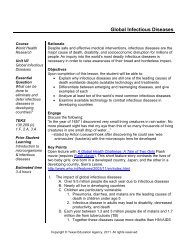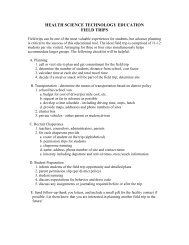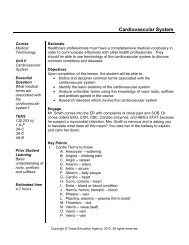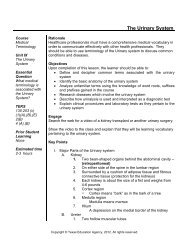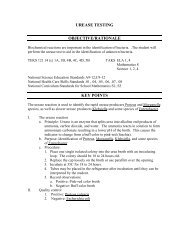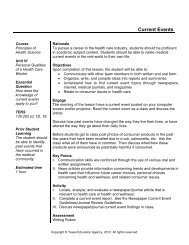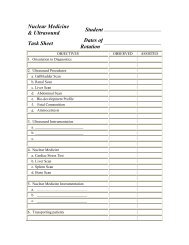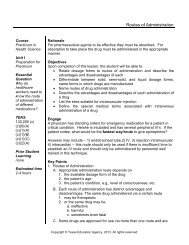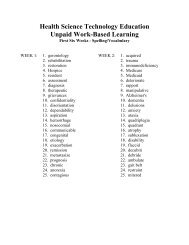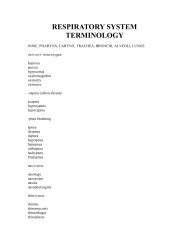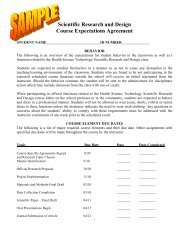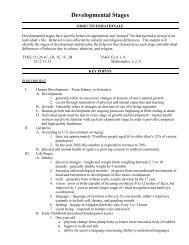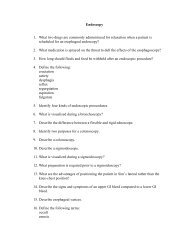Nervous System - Texas Health Science!
Nervous System - Texas Health Science!
Nervous System - Texas Health Science!
Create successful ePaper yourself
Turn your PDF publications into a flip-book with our unique Google optimized e-Paper software.
<strong>Nervous</strong> <strong>System</strong>CourseMedicalTerminologyUnit X<strong>Nervous</strong> <strong>System</strong>EssentialQuestionWhat medicalterms areassociated withthe nervoussystem?TEKS130.203 (c)1 A-F2A-C3A-C4A-BPrior StudentLearningBasicunderstanding ofroots, prefixes,and suffixesEstimated time4-7 hoursRationale<strong>Health</strong>care professionals must have a comprehensive medical vocabulary inorder to communicate effectively with other health professionals. Theyshould be able to use terminology of the nervous system to discuss commonconditions and diseases.ObjectivesUpon completion of this lesson, the student will be able to define and decipher common terms associated with the nervoussystem; identify the basic anatomy of the nervous system; analyze unfamiliar terms using the knowledge of word roots, suffixesand prefixes gained in the course; and research diseases which involve the nervous systemEngageMr. Smith comes in to Dr. Anderson’s office, accompanied by his wife,complaining of memory problems. Is this just part of the natural agingprocess or is it something more serious?Key PointsI. <strong>Nervous</strong> system words to knowA. cerebr/o – cerebrum (brain)B. dur/o – dura mater (hard, tough)C. encephal/o – brainD. cephal/o – headE. myel/o – medulla (also marrow)F. myelin/o – myelin (Schwann cells)G. neur/o – nerveH. radic/o, radicul/o – nerve rootI. psych/o – mindJ. ment/o – mindK. -paresis – slight paralysisL. -plegia – paralysis, strokeM. gangli/o, ganglion – swelling, ganglion (pl=ganglia)N. mening/i, mening/o – meninges (membrane)O. esthesi/o – sensationP. phas/o – speechQ. poli/o – gray matterR. phren/o – mind (also diaphragm)S. scler/o – hardCopyright © <strong>Texas</strong> Education Agency, 2012. All rights reserved.
II.III.IntroductionA. The most highly organized system of the bodyB. A fast, complex communication system that regulates thoughts,emotions, movements, impressions, reasoning, learning, memory,and choicesC. Basic Characteristics1. Master control system2. Master communication system3. Regulates and maintains homeostasisD. Functions1. Monitors change (stimuli) – sensory input2. Integrates impulses – integration3. Affects responses – motor outputOrganization of the <strong>Nervous</strong> <strong>System</strong>A. CNS (Central <strong>Nervous</strong> <strong>System</strong>)1. The brain and spinal cord2. Integrates incoming pieces of sensory information, evaluatesthe information, and initiates the outgoing responses3. No potential for regenerationB. PNS (Peripheral <strong>Nervous</strong> <strong>System</strong>)1. Made of 12 pairs of cranial nerves and 31 pairs of spinalnerves2. Afferent (sensory) divisiona. Carries impulses toward the CNSb. Somatic (skin, skeletal muscles, and joints)c. Visceral (organs within the ventral cavity)3. Efferent (motor) divisiona. Somatic – carries information to the skeletal muscles(reflex and voluntary control)b. Autonomic – involuntary; regulates smooth muscles,cardiac muscle, and glandsi. Sympathetic – exits the thoracic area of the spinalcord; involved in preparing the body for “fight orflight”ii. Parasympathetic – exits the cervical and lumbarareas of the spinal cord; coordinates the body’snormal resting activities (resting and digestingrepairing)IV. Histology of <strong>Nervous</strong> TissueA. Basic Characteristics1. Highly cellular2. Two types of cells – neurons and supporting cells (neuroglia)B. Neuroglia characteristicsCopyright © <strong>Texas</strong> Education Agency, 2012. All rights reserved.
1. A dense network of supporting cells for nerve tissue2. Over 900 billion cells3. Can replace themselves4. glia = glue5. Supportive scaffolding; insulation; neuron health and growth6. Six types (four in the CNS, two in the PNS)7. Tic douloureux – a painful disorder; supporting cells of fibersof the trigeminal nerve (main sensory nerve of the face)degenerate – touch sensations stimulate uninsulated painfibers – agonizing pain with the softest touchC. Neuroglia1. Astrocytes – star-shaped cells in the CNSa. Most abundant; cling to neurons and capillariesb. Make tight sheaths around the brain’s capillariesforming the blood-brain barrier that regulates thepassage of certain molecules into the brainc. Controls the chemical environment (leaked K+,recaptured/recycled neurotransmitters)2. Microglia – small, ovoid, thorny cells in the CNS;phagaocytic cells that fight infection by engulfing microbes3. Ependymal – squamous to columnar; some ciliated in theCNSa. Form thin sheaths that line the ventricles and spinalcanalb. Help form the Cerebrospinal fluid (CSF)c. There is a permeable barrier between the CSF and theCNSd. Cilia circulate the CSF4. Oligodendrocytes – in the CNSa. Form myelin sheaths around axons of the CNSb. Forms “white matter” of the brain and spinal cordc. Multiple Sclerosis – a disease of the oligodendrocyteswhere hard lesions replace the myelin and affectedareas are invaded by inflammatory cells; nerveconduction is impaired; chronic deterioration of themyelin of the CNS with periods of remission andrelapse; causes: autoimmunity or viral5. Schwann cells – in the PNSa. Neurolemmocytesb. Form myelin sheaths around the axons of the PNSc. The area between the Schwann cells form gaps calledthe Nodes of Ranvierd. As each Schwan cell wraps around the axon, itsnucleus and cytoplasm are squeezed to the perimeterto form the neurilemma (sheath of Schwann) which isessential for nerve regenerationCopyright © <strong>Texas</strong> Education Agency, 2012. All rights reserved.
e. Also act as phagocytes (cell debris)6. Satellite/attendant cells – in the PNSa. Surround neuron cell bodies within the gangliab. Control the chemical environmentD. Neurons1. Over 100 billion2. Highly specialized3. Send messages in the form of nerve impulses4. Extreme longevity (>100 years)5. Amitotic (no centrioles)6. High metabolic rate7. 3 functional components in commona. receptive/input regionsb. conducting component/trigger zonec. secretory/output componentE. Neuron cell body1. Nucleus2. Cytoplasm – contains neurofibrils (convey impulses)3. Nissl bodies – for protein synthesis; rough endoplasmicreticulum (ER)4. No centrioles; therefore they cannot divide by mitosis5. Axona. A long, slender fiber that transmits impulses away fromthe cell bodyb. One per neuronc. Short, absent, or long (great toe – the lumbar region:three to four feet = longest cells in the body)d. The long ones are called nerve fiberse. The largest in diameter have the most rapid conductionf. The distal tip of the axon ends in a synaptic knob orend plate6. Dendritesa. Short, tapering, diffusely branched (tree-like) fibersb. Carry impulses toward the cell body from sensoryreceptors or other axonsF. Myelin sheath1. Whitish, fatty (protein lipoid), segmented covering of theaxons2. Myelinated fibers – conduct nerve impulses rapidly; electricalinsulation3. Unmyelinated fibers – conduct impulses slowly4. White matter – myelinated sheaths around the axons of thePNS; gives the tissue a white color and forms myelinatednerves (axons = myelinated tracts)5. Gray matter – concentrations of cell bodies andunmyelinated fibers (in the PNS = ganglia; in the CNS =Copyright © <strong>Texas</strong> Education Agency, 2012. All rights reserved.
nuclei)G. Nerves1. Bundles of PNS fibers held together by several layers ofconnective tissue2. Endoneurium – fibrous connective tissue surrounding eachnerve fiber3. Perineurium – connective tissue holding together bundles offibers4. Epineurium – fibrous tissue holding the whole nerve togetherH. Synapse1. Space between nerve fibers; the place where nerveimpulses are transmitted from one neuron to another2. The axonal terminal contains synaptic vesicles (membranebound sacs containing neurotransmitters)3. The receptor region on the dendrite4. Synaptic cleft – microscopic gap that exists between theneuronsV. NeuronsA. Characteristics (see the Neuron Diagram)1. Excitability – the ability to react to a stimuli, physical orchemical2. Irritability – sensory adaptation; with prolonged stimulation,irritability is temporarily lost (i.e. smell)3. Conductivity – the ability to transmit an impulsea. Nonmyelinated fibers = 0.5-1 meter/sec (1 mph)b. Myelinated fibers = 80-130 meters/sec (300 mph)B. Structural classification of neurons – the number of processesextending from cell bodies (see the Types Of Neurons Diagram)1. Multipolar – several (three or more) dendrites and one axon;most common; motor2. Bipolar – two processes; one axon and one dendrite at eitherend of the cell body; rare; retina of the eye, olfactorymucosa, and inner ear3. Unipolar/pseudounipolar – a single process; originates asbipolar then the processes fuse; a single short process fromthe cell body that divides like a T; ganglia of the PNS assensory neuronsC. The functional classification of neurons – the direction in whichthe nerve impulse travels relative to the CNS1. Sensory/afferent – the dendrites are connected to receptorswhere stimulus is initiated in the skin/organs and carry animpulse toward the CNS; the axons are connected to otherneuron dendrites; they are unipolar except for the bipolarneurons in special sense organs; cell bodies in sensoryganglia outside the CNSCopyright © <strong>Texas</strong> Education Agency, 2012. All rights reserved.
a. Receptors – extroceptors (pain, temperature, touch);interoceptors (organ sensation); proprioceptors (musclesense, position, movement)2. Motor/Efferent – carry messages from the CNS to effectors;the dendrites are stimulated by other neurons and the axonsare connected to effectors (muscles and glands); they aremultipolar except for some in the autonomic nervous system(ANS)3. Association/Interneurons – carry impulses from one neuronto another (afferent to efferent); found only in the CNS; liebetween the sensory and motor neurons; shuttle signals;99% of the neurons in the bodyVI. RegenerationA. Neurons do not reproduce themselves, but they can regeneratenew parts sometimesB. If a neuron is cut through a myelinated axon, the proximal portionmay survive if the cell body is not damagedC. The distal portion will die (degenerate). Macrophages move intothe area and remove debrisD. A neuron cell body reorganizes its Nissl bodies to provide theproteins necessary for axon growthE. The Schwann cells form a regeneration tube that helps guide theaxon to its proper destinationF. New fibers will eventually fill the myelin sheath and innervate themuscle. Growth occurs at 3-5 mm/day (1mm = 0.04in)G. In the CNS, this repair is unlikely because the neurons lack theneurilemma necessary to form the regeneration tube. Also, theastrocytes quickly fill the damaged area, forming scar tissue. MostCNS injuries cause permanent damageH. Crushing and bruising can also damage nerve fibers, resulting inparalysis. Inflammation of the injury site damages more fibers.Early treatment with methyprednisolone reduces inflammationand decreases the severity of the injury. It must be given within 8hours to be effectiveVII. Conduction (“All or None Law”) – when stimulated, a nerve fiber willeither respond completely or not at allA. Electrical – along the nerve1. Resting fiber = polarized = -70mVa. An excess of negative ions on the inside of themembrane and an excess of positive ions on theoutside of the membraneb. The electrical difference is called the membranepotential. It is measured in millivolts, so -70 mVindicates that the potential difference has a magnitudeCopyright © <strong>Texas</strong> Education Agency, 2012. All rights reserved.
of 70 mV and the inside of the membrane is negative2. With a stimulus, a “sodium pump” is created – three Na+move across the membrane and flow into the cell and twoK+ diffuse out of the cell; the membrane is now depolarized3. Myelinated fibers are able to conduct impulses fasterbecause the Na+/K+ exchange can only occur at the node,so impulses leap from node to node4. Before another electrical current can spread along the nervefiber, the membrane must repolarize to its original condition.The refractory time is a brief period when a neuron resistsrestimulation until repolarization is complete5. The impulse can never move backwardB. Chemical – at the synapse (see the Chemical Synapses Diagram)1. The impulse arrives at the presynaptic terminal axon2. This impulse causes Ca++ to enter the axon knob3. The Ca++ causes synaptic vesicles to migrate to thepresynaptic membrane and release hundreds ofneurotransmitters into the synaptic cleft4. The neurotransmitter binds with receptors on thepostsynaptic membrane. Function is therefore determined bythe post synaptic receptors, not by the neurotransmitter5. This binding opens channels in the post synaptic membrane,so Na+ moves into the post-cell and K+ moves out –temporary depolarization6. This causes excitation and the impulse is on its way –conduction has occurred7. Some neurotransmitters are transported back into thepresynaptic knob, where they are repackaged into vesiclesand used againC. Neurotransmitters1. Acetylcholine (ACh) – the most common, it excites skeletalmuscle, but inhibits cardiac muscle; is also involved withmemory; a deficiency of ACh could be a cause ofAlzheimer’s2. Amines – synthesized from amino acid moleculesa. Serotonin – a CNS inhibitor; moods, emotions, andsleepb. Histamine – a CNS stimulant; regulation of waterbalance and temperature, and emotionsc. Dopamine – has an inhibitory effect on the somaticmotor system; without dopamine the body has ageneral overstimulation of muscles = Parkinsoniantremors; cocaine blocks the uptake of dopamined. Epinephrine – autonomic nervous response, betareceptors, and dilatione. Norepinephrine – autonomic nervous response, alphaCopyright © <strong>Texas</strong> Education Agency, 2012. All rights reserved.
eceptors, and constriction; antidepressants increasethe amount of norepinephrine in brain, relievingdepression3. Amino acidsa. Glutamate – CNS excitatoryb. Glycine – CNS inhibitory4. Neuropeptides – short strands of amino acids calledpolypeptidesa. Enkephalins/endorphins – inhibitory; act like opiates toblock painb. VIP – vasoactive intestinal peptidec. CCK – cholecystokinind. Substance P – excitatory, transmits pain informationVIII. Reflex – a reflex arc is a conduction route to and from the CNS; aregulatory feedback loop (see the Reflex Arc Diagram)A. Structure1. Sensory receptor in the PNS2. Sensory afferent neuron3. Interneuron(s) in the CNS4. Motor efferent neuron5. Effector (muscle/gland) tissue in the PNSB. Types1. Deep tendon reflex – patellar tendon, knee jerk2. Pupil reflex – to light or dark, constricts or dilates3. Corneal reflex – with touch, causes blinking4. Gag reflex – to touch, sight, and smell5. Plantar reflex – negative Babinski response; toes curl underwhen the sole is strokedC. First level reflex1. Predictable, fast, automatic2. The impulse travels only to the spinal cord3. Example – jerking your hand away from a hot stoveD. Second level reflex1. Impulse travels to the brain stem2. Usually protective3. Example – coughing or vomitingE. Third level reflex1. Learned or conditioned reflex2. Involves the cerebral cortex3. Example – bowel or bladder controlF. Ipsilateral – receptors and effectors are located on one side of thebodyG. Contralateral – receptors and effectors are located on oppositesides of the bodyCopyright © <strong>Texas</strong> Education Agency, 2012. All rights reserved.
IX. Central <strong>Nervous</strong> <strong>System</strong> (see the Brain Diagram)A. Brain – a mass of 12 billion neurons and neuroglia weighingapproximately three pounds, and protected by cranial bonesB. Cerebrum – largest percentage mass of the brain (83% of brainmass); responsible for higher mental functions and the distributionof impulses (see the Gray and White Matter Diagram)1. Cerebral cortex – the outer layer of gray matter; short- andlong-term memorya. Convolutions – elevated ridges or folds that increasethe gray area of brainb. Sulci – shallower groovesc. Fissures – deep grooves (fetal folds)i. Longitudinal – separates the right and lefthemispheres; corpus callosum (large fibers thatconnect the two hemispheres)ii. Transverse – separates the cerebrum from thecerebellumiii. Fissure of Rolando – divides the frontal andparietal lobes at the coronal sutureiv. Fissure of Sylvan/lateral fissure – divides thefrontal and temporal lobes2. Cerebral medulla – white matter, conduction pathways3. Divided into right and left hemispheres (the left side governsthe right side of the body, the right side governs the left sideof the body)4. Lobesa. Frontal – voluntary motor control, learning, planning,and speechb. Parietal – sensory, distance, size, shape, andcognitive/intellectual processesc. Occipital – vision and visual memoryd. Temporal – auditory, olfactory, speech, judgment,reasoning, and willpowerC. Cerebellum – below and posterior to the cerebrum1. The right and left hemispheres are connected by the centralvermis2. Outer gray, inner white forms the arbor vitae3. Coordinates muscular movement, posture, balance, running,and walking4. Damage produces ataxia (a lack of coordination due toerrors in speed, force, and direction of movement)D. Brainstem (damage = coma) (see the Pons and MidbrainDiagram)1. Midbrain – the upper part of the brainstema. Controls postural reflexes and walkingb. Visual reflexes and auditory control, 3-4 cranial nervesCopyright © <strong>Texas</strong> Education Agency, 2012. All rights reserved.
2. Pons – a two-way conduction pathway; mixed gray andwhite fibersa. Controls inspirationb. Transverse fibers give it a bridge appearancec. Reflex mediation for 5-8 cranial nerves3. Medulla oblongata – the bulb (the lowest part before theforamen magnum); made of white and gray fibers called thereticular formationa. 75% of nerve fibers cross hereb. Controls vital functions – respiration and circulationc. Pyramids – bulges of white tracts on the ventral surfaceE. Diencephalon – the area between the cerebrum and the midbrain1. Thalamus – gray matter, the relay station for sensoryincoming and motor outgoing impulses; damage = increasedsensitivity to pain and loss of consciousness2. Hypothalamus – forms the floor of the third ventriclea. Regulates autonomic controlb. Cardiovascular control – dilates and constrictsc. Temperature controld. Controls appetite – hunger and thirste. Water balancef. GI control – peristalsis, intestinal secretionsg. Emotional states – fear, anger, pleasure, pain, andsexual reflexesh. Sleep controli. Regulates pituitary secretionsj. CHO and fat metabolism3. Epithalamus – contains the pineal body/gland (melatonin)F. Meninges – three membranous coverings with spaces betweeneach1. Dura mater – “tough mother”; strong, white, fibrous tissuethat lines the skull bones; has inward extensions into thefissuresa. Epidural space – between the bone and the dura materb. Subdural space – between the dura and arachnoidlayers2. Arachnoid – resembles fine cobwebs with fluid (CSF) fillingthe spacesa. Subarachnoid space – between the arachnoid and pialayers3. Pia mater – “tender mother”; covers the brain and spinalcord surfaceG. Cerebrospinal Fluid (CSF) – bathes the skull, brain, and spinalcord (see the Spinal Cord Protective Covering Diagram)1. Serves as a shock absorber for the brain and spinal cord2. 400-500 ml produced daily, yet only 140 ml is circulating atCopyright © <strong>Texas</strong> Education Agency, 2012. All rights reserved.
any time3. Circulates through the ventricles and into the central canaland subarachnoid spaces, and is absorbed back into theblood4. Provides nutrients and waste removal for brain tissues5. It is clear, colorless, and composed of water, 40-60%glucose, NaCl, K+, protein, and a few white blood cellsH. Ventricles – CSF-filled spaces of the brain; the rich network ofblood vessels, the choroid plexus, maintains selectivepermeability to protect brain tissue1. Foramen of Monro – connects the lateral ventricles to thethird ventricle (behind and below the laterals)2. Aqueduct of Sylvus – connects the third and fourth ventricle3. In the roof of the fourth ventricle are openings, the foramenof Magendie and foramen of Luschka, that allow the CSF tomove into the cisterna magna, a space behind the medullathat is continuous with the subarachnoid spaceI. Spinal cord1. Deep grooves – anterior median fissure (deeper) andposterior median sulcus2. Two bundles of nerve fibers, called roots, project from eachside of the corda. Dorsal nerve root – sensory afferent fibersb. Dorsal root ganglion – sensory cell bodiesc. Ventral nerve root – motor efferent fibersd. The nerve roots join together to form a single, mixednerve called a spinal nerve3. “H”a. The gray matter of cell bodies of interneurons andmotor neurons, divided into anterior, posterior, andlateral hornsb. White matter surrounds gray “H”; divided into anterior,posterior, and lateral columns (large bundles of nerveaxons divided into smaller bundles called tracts);ascending and descending, and lateral organizationaltractsc. Transcutaneous electrical nerve stimulation unit(TENS) – acts to close the gates of the ascendingtracts; therefore pain impulses are not allowed to get tothe braind. Lumbar puncture – a spinal tap between the 3rd and4th lumbar vertebrae for CSF diagnosticsX. Peripheral <strong>Nervous</strong> <strong>System</strong>A. Cranial Nerves – twelve pairs: “On Old Olympus’ Towering Top, AFinn, and German Grew Some Hops”, “Some Say Marry MoneyCopyright © <strong>Texas</strong> Education Agency, 2012. All rights reserved.
But My Brother Says, Bad Business, Marry Money”1. Olfactory – I: sensory, smell2. Optic – II: sensory, vision3. Oculomotor – III: motor, eye movement and pupil4. Trochlear – IV: motor, eye movement, peripheral vision5. Trigeminal – V: both, ophthalmic maxillary, mandibular(sensory); face and head (motor)6. Abducens – VI: motor, abducts eye7. Facial Nerve – VII: both, facial expression, taste, tonguemovement8. Vestibulocochlear – VIII: sensory, hearing and balance9. Glossopharyngeal – IX: both, tongue, throat, swallowing10. Vagus – X: both, organ sense (thoracic and abdominal)inhibitor11. Accessory – XI: motor, spinal accessory, shoulder and headmovement12. Hypoglossal – XII: motor, tongue and throat movementB. Spinal Nerves – 31 pairs of mixed nerves attached to the spinalcord via ventral and dorsal roots1. Eight cervical (pass through intervertebral foramina), twelvethoracic, five lumbar (exit the cord at the 1st lumbar vertebra,but do not exit the spinal canal until reaching theirintervertebral foramina; this gives the cord a “cauda equina”look), five sacral, one coccygeal2. Each nerve splits into several large branches + rami, whichsubdivide into four complex networks called plexuses(cervical, brachial, lumbar, sacral)3. Dermatome is an area of skin that is mainly supplied by asingle spinal nerveXI. Special SensesA. Sense of taste1. Chemoreceptors respond to chemicals in an aqueoussolution2. Taste – gustation3. Taste buds – sensory receptor organs for taste; primarily onthe tongue papillae4. Primary sensations: sweet, salty, sour, bitter5. Sensitivitya. Tip of the tongue – sweet and saltyb. Sides of the tongue – sourc. Back of the tongue – bitter6. Thresholdsa. Bitter – minute amountsb. Sour – less sensitivec. Sweet and salty – least sensitiveCopyright © <strong>Texas</strong> Education Agency, 2012. All rights reserved.
7. Anterior 2/3 of tongue sensory stimulation travels via thefacial nerve to the parietal lobe of the cerebral cortex forinterpretation and appreciation of what is being tasted8. Posterior 1/3 of tongue sensory stimulation travels via theglossopharyngeal nerve to the medulla oblongata and thento the parietal lobe of the cerebral cortex for interpretation9. 80% of taste is actually smell10. Other influences – thermoreceptors, mechanoreceptors,nocioreceptors (temperature and texture enhance or distractfrom taste, i.e. chili peppers stimulate the pain receptors)B. Sense of smell1. Specialized neurons with olfactory cilia in the upper nasalcavity2. Stimulated by gas molecules or chemicals3. Sniffing draws air forcefully up into the nose4. Sensory cells live for an average of 30 day5. Sensory cells are affected by a variety of factors – age,nutrition, hormones, drugs, and therapeutic radiation6. When stimulated, send impulses via the olfactory nerve tothe cerebral cortex for interpretation7. Smell memory is long-lasting and stimulation by similarsmells can trigger memories of events that occurred longago8. Olfactory receptors are easily fatigued – adaptation occursa. The process of conforming to the environment aftercontinuous stimulation of a constant intensityb. These changes in awareness of odors allow us tocontinue to function at an optimum level9. Seven primary odors – floral, musky, camphorous,pepperminty, ethereal, pungent (stinging), putrid (rotten)10. Homeostatic imbalancesa. Anosmias – without smell; some genetic causes, headinjuries that tear the olfactory nerves, aftereffects ofnasal cavity inflammation (cold, allergy, smoking),physical destruction of the nasal cavity due to polyps,aging, zinc deficiencyb. Uncinate fits – olfactory hallucinations, epileptic auras(transient uncinate fits)C. Sense of vision (see the Eye Diagram)1. Anatomya. Eyebrows – physical protection of the eyes; short,coarse hairsb. Eyelids (palpebrae) – physically protect the eye andprevent the cornea from drying via the blink reflex;medial and lateral canthi (angle of eye); caruncle(fleshy elevation of the medial canthus which containsCopyright © <strong>Texas</strong> Education Agency, 2012. All rights reserved.
sebaceous and sweat glands to produce “Sandman’seye-sand”)c. Eyelashes – hairs with glands at the base forlubrication; inflammation = a styd. Meibomian glands – secrete a lipid tear film spread byblinking; reduces evaporation of the tear film, preventsthe tear film from running down the face; gives an evenspread over the eyeball; inflammation = chalazione. Lacrimal glands – secrete an aqueous tear filmcontaining globulins and lysozyme; suppliesnourishment to the cornea and helps to provideantimicrobial activity; nasolacrimal duct (empties intothe nasal cavity; excess tears = tearing, nasalsecretions; secretions decrease with age)f. Conjunctiva – the membrane that lines the eyelid;secretes a mucous tear component that helps reducesurface tension; it accumulates at the medial canthus(corner angle) as “sleep”; inflammation = pinkeyeg. Extrinsic eye muscles – annular ring (tendinous ringfrom which originate the rectus muscles); rectusmuscles (superior, inferior, lateral, and medial eachmoves the eye in direction of its name); obliquemuscles (superior, inferior each moves the eye in thevertical plane when the eye is turned medially by therectus muscle); diplopia = double vision whenmovements are not perfectly coordinated, and inabilityto focus both eyes; strabismus = congenital weaknesscausing a cross-eyed appearance (the deviant eyebecomes functionally blind)h. Sclera – the outermost white covering of the eyeball;anchor site for musclesi. Cornea – the transparent front of the sclera; it has noblood vessels but is richly supplied with sensorynerves; depends on tear film for nutrition, O 2 , andremoval of waste; a window for light to enter;extraordinary capacity for regeneration; transplantationwithout rejection due to avascular naturej. Choroid – the highly vascular middle layer of eye; darkmembrane on the posterior wall inside the eye;provides nutrients to all tunics; pigment absorbs light toprevent scatter and reflection internallyk. Ciliary body – encircles the lensl. Anterior chamber – between the cornea and the iris;filled with an aqueous humor that supplies nutrients tothe cornea; helps maintain the ocular shape; constantlybeing formed; excess drains through the canal ofCopyright © <strong>Texas</strong> Education Agency, 2012. All rights reserved.
Schlemm to the bloodstream; the amount regulatesintraocular pressure; increased pressure = glaucoma,which results in atrophy of the optic nerve andblindnessm. Iris – the visible, colored part of the eye; musclescontrol pupil size which regulates the amount of lightentering the lens; sympathetic = dilation,parasympathetic = constrictionn. Pupil – the round central opening of the iris; allows lightto entero. Lens – a transparent spherical structure suspended bysuspensory ligaments between the iris and the vitreoushumor; being a convex lens – 1/3 of the refractivepower of the eye; accommodation = as objects arebrought closer to the eye, the ciliary muscles contractand make the lens more convex, increasing itsrefractive power; (presbyopia = during the agingprocess, the lens loses elasticity; diabetes – excessglucose draws water into the lens causing opacitychanges = cataracts)p. Vitreous humor – secreted by the retinal cells; makesup the posterior chamber; maintains the shape of theeye, positions the retina against the choroid, andtransmits lightq. Retina – the innermost pigment layer of the eye wherethe rods and cones (visual receptors) are located;absorbs light and recycles visual pigments; visualpigments, rhodopsin (in rods – dim light, peripheralvision) and Iodopsin (in cones – bright light, high acuity,color vision), are converted into opsin and reinene(vitamin A derivative) which stimulate the bipolarneurons (converge to form optic nerve); diabeticretinopathy = small, retinal hemorrhages occur due toexcess glucose in the blood – disrupts O 2 to the rodsand cones – blindness; nyctalopia = deficiency ofvitamin A – night blindnessr. Fovea – the focus point for light rays for the best visualacuity; composed mostly of cone cellss. Optic disc – the “blind spot” where neurons exit theeyeball as the optic nerve2. Sense of sighta. Light waves are bent first by the cornea, the eye’s fixedouter lens; bending of the light rays = refraction; the iris,whose pigment gives an eye its color, contracts inbright light and expands in dim light to regulate theamount of light entering the pupil; ciliary musclesCopyright © <strong>Texas</strong> Education Agency, 2012. All rights reserved.
around the inner crystalline lens flex to focus the imageprecisely on the retina, a thin sheet of nerve tissueb. Light floods the retina and activates the photoreceptors,called rods and cones (due to their shape); conesspecialize in bright light and are concentrated in acentral patch of the retina called the fovea; conesprovide acute central vision, rich with color; thecolorblind rods enable us to see in dim light; signalsfrom the rods and cones are sent to the cerebral cortexvia the optic nerve; as much as 1/3 of the cortex isdevoted to visual processing; sight mediates andvalidates the other sensesc. At the optic chiasm, the nerve splits, distributing inputfrom each eye to relay stations in the thalamus; thiscircuitry enables us to see with one eye if necessary;different neurons transmit data about motion, color, finedetail, and depth perceptiond. The visual area of the temporal cortex identifies andrecognizes the object; an area of the parietal cortexlocates the object in relation to spacee. Visual acuity – the clearness or sharpness of visualperception recorded as two numbersi. The first number represents the distance in feetbetween the subject and the test chart (SnellenChart)ii. The second number represents the number of feetaway that a person with normal acuity would standto see clearlyiii. 20-20 is considered normal acuityiv. 20-100 means a person can see objects at 20 feetthat a person with normal vision can see at 100feetv. Visual acuity worse than 20-200 after correction isconsidered legally blindf. Homeostatic imbalancesi. Myopia – nearsighted; focus falls short of theretina; far objects are blurred; radial keratotomycan correct or improve this conditionii. Hyperopia – farsightedness; focus falls behind theretina; close objects are blurrediii. Astigmatism – the cornea is not spherical; thefocused image is distortediv. Color blindness – a congenital lack of one or moretypes of cones (red, green, blue); sex-linkedD. Sense of hearing (see the Ear Diagram)1. Anatomy of the external earCopyright © <strong>Texas</strong> Education Agency, 2012. All rights reserved.
a. Auricle (pinna) – the flap that funnels sound waves;helix = rim; lobule = earlobeb. External auditory meatus – the opening to the auditorycanal, lined with cerumen/wax glandsc. External auditory canal – a short, narrow chamberextends from the auricle to the tympanic membraned. Tympanic membrane – the eardrum, that stretchesacross the canal and vibrates in response to soundwaves; transmits them to the middle ear2. Anatomy of the middle ear – tiny cavity in the temporal bonea. Auditory ossicles – three bones that vibrate to transmitsound waves to the inner eari. Malleus – a hammer-shaped, handle is attached tothe tympanic membraneii. Incus – anvil-shapediii. Stapes – stirrup-shapedb. Oval/vestibular window – opens to the internal earc. Round/Cochlear window – covered by a membrane;opens to the internal eard. Pharyngotympanic/auditory/Eustachian tube – connectsthe middle ear to the pharynx; helps to equalizepressure so the eardrum will vibrate; children’s tubesare more horizontal – otitis media (myringotomy =lancing of the eardrum to relieve pressure – insertion oftubes for drainage of fluid/pus)e. Mastoid sinuses – air spaces in the temporal bone thatdrain into the middle ear3. Anatomy of the inner ear – labyrinth, located in the hollowedout portion of the temporal bonea. Vestibule and semicircular canals – involved inequilibrium; maculae found in the utricle and sacule ofthe vestibule provide information related to headposition; crista ampullaris in the semicircular canalsrespond to angular/rotational movements of the head;tiny otoliths detect changes due to position andstimulate a reflex to restore normal body positionb. Cochlea – the snail-like part of the inner ear for hearing;surrounded by perilymph and filled with endolymph fluidi. The upper section is the scala vestibuliii. The lower section is the scala tympaniiii. Reissner’s membrane = the floor of the cochleaiv. Basilar membrane = the floor of the cochleav. Organ of Corti – the receptor organ for hearing –the eighth cranial nerve; the sense organ thatrests on the basilar membrane, consisting of haircells; sensory dendrites are wrapped around theCopyright © <strong>Texas</strong> Education Agency, 2012. All rights reserved.
ase of the hair cells; they transmit impulses to theaxons that form the auditory (acoustic) nerve4. The physiology of hearinga. Sound waves are caught by the auricle, channeledthrough the auditory canal, and strike against thetympanic membrane causing it to vibrateb. Vibrations move the malleus, incus, and stapes againstthe oval windowc. Pressure is exerted inward into the perilymph of thescala vestibulid. A ripple starts in the perilymph that is transmittedthrough the vestibular membrane to the endolymphinside the organ of Cortie. The endolymph ripple causes the basilar membrane tobulge up in response to sound wave vibrations; thehigher the upward bulge, the more cilia are bent, themore cells are stimulated on the basilar membranef. The stimulated cells transmit nerve impulses along theauditory nerveg. Impulses travel to the auditory cerebral cortex – areinterpreted as soundh. Sound volume is determined by the height (amplitude)of the waves; sound pitch is determined by thefrequency of the waves; the decibel unit is used formeasuring the volume of soundDecibelLevelExample of Noise0Lowest audiblesound30 Quiet library50 Refrigerator noiseDangerousTime70 Noisy restaurant Critical level80 Factory noise 8 + hours90 Shop tools Impairment100 Chain saws < 2 hours120 Rock concertImmediateharm140 Gunshot blastDamageprobable180 Rocket launchpadPermanentloss5. Homeostatic imbalancesCopyright © <strong>Texas</strong> Education Agency, 2012. All rights reserved.
a. Conduction deafness – something interferes with theconduction of sound vibrations to the fluids of the innerear, i.e. impacted earwax, perforated/ruptured eardrum,otitis media, otosclerosis of ossiclesb. Sensorineural deafness – damage to the neuralstructures at any point, from the cochlear hair cells tothe auditory cortical cells; can be the gradual loss ofreceptor cells, exposure to a single loud noise,degeneration of the cochlear nerve, cerebral infarcts, ortumors; treatment can be cochlear implantsc. Tinnitus – a ringing or clicking sound in the ears in theabsence of auditory stimuli; can be the first symptom ofcochlear nerve degeneration, inflammation of themiddle/inner ear, or the side effect of somemedications, i.e. aspirind. Meniere’s Syndrome – a labryrinth disorder that affectsthe semicircular canals and cochlea; transient butrepeated attacks of severe vertigoe. Presbycusis – loss of the ability to hear high-pitchedsounds; becoming common in young people due tonoiseE. Sense of touch, heat, cold, and pain1. Sensory receptors make it possible for the body to respondto environmental stimuli2. Receptors respond to a stimulus and convert the stimulus toa nerve impulse3. Nerve impulses travel via afferent sensory neurons to thebrain for interpretation4. Touch – mechanoreceptors/exteroceptors; located on thebody surfaces; respond to touch, stretch, and pressurea. Meissner’s corpuscles – in the fingertips, lips, andhairless body parts for fine touchb. Pacinian corpuscles – in the skin, joints, and genitalsfor deep pressure and stretchc. Krause’s end bulbs – in the eyelids, lips, and genitalsfor light touchd. Ruffini’s corpuscles – found in the skin for continuoustouch5. Heat/cold – thermoreceptors6. Pain – nocioceptors; free nerve endings for pain, tickling,itching; noci = pain, injuryXII. Disorders of the <strong>Nervous</strong> <strong>System</strong>A. Shingles – herpes zoster viral infection; causes inflammatoryvesicles along the peripheral nervesB. Neuralgia – a sudden, sharp severe stabbing pain along a nerveCopyright © <strong>Texas</strong> Education Agency, 2012. All rights reserved.
pathwayC. Neuritis – inflammation of a nerve; causes pain, muscularatrophy, hypersensitivity, and paresthesiaD. Tic douloureux – degeneration of the trigeminal nerves; causesrepeated, involuntary muscle twitchingE. Bell’s palsy – unilateral facial paralysis, sudden onset, viralinflammation of the trigeminal nerveF. Poliomyelitis – (polio) is a highly infectious viral disease, whichmainly affects young children. The virus is transmitted throughcontaminated food and water, and multiplies in the intestine, fromwhere it can invade the nervous system; permanent paralysis orweaknessG. Encephalitis – a viral inflammation of brain tissue; causes fever,lethargy, weakness, nuchal rigidity and opisthotonos, coma, anddeathH. Meningitis – a bacterial or viral inflammation of the meninges;causes headache, fever, sore throat, back and neck pain, andloss of mental alertnessI. Meningiocele – a congenital hernia in which the meningesprotrude through an opening in the spinal cordJ. Epilepsy – idiopathic recurring and excessive electrical dischargefrom neurons causing seizure activity (grand mal, petit mal)K. Hydrocephalus – an increased accumulation of CSF within theventricles; causes the cranium to enlarge unless treated with ashunt to remove excess fluidL. Parkinson’s disease – tremors, uncontrolled shaking; related todecreased amounts of dopamineM. Huntington’s chorea – a progressive dementia with bizarreinvoluntary movements; geneticN. Athetosis – slow, irregular, twisting, snakelike movements of thehandsO. Hemiballism – jerking and twitching movements of one side of thebody; caused by a tumor of the thalamusP. Dysmetria – an inability to fix the range of movement in muscleactivityQ. Cerebral palsy – a congenital brain disorder/damage causingdamage to motor neurons; flaccid or spastic paralysisR. Multiple sclerosis – autoimmunity destruction of oligodendrocytesleading to demyelination with progressive muscular weaknessS. Muscular dystrophy – a genetic defect in muscle metabolism;causes progressive atrophyT. Myasthenia gravis – a disease characterized by muscularweakness, possibly due to decreased amounts of acetylcholine atthe muscle effector sitesU. Alzheimer’s disease – dementia-producing lesions in the cerebralcortexCopyright © <strong>Texas</strong> Education Agency, 2012. All rights reserved.
V. Anencephalic – infants born without a frontal cerebrum;congenital, possibly related to toxins, may be related to a folicacid deficiency in the motherActivityI. Make flash cards of neurological terms and practice putting the termstogether with prefixes and suffixes to make new terms.II. Complete the <strong>Nervous</strong> <strong>System</strong> Worksheet.III. Complete the <strong>Nervous</strong> <strong>System</strong> Medical Terminology Worksheet.IV. Review media terms with the students using review games such as the“Fly Swatter Game” or the “Flash Card Drill” (see the MedicalTerminology Activity Lesson Plan -http://texashste.com/documents/curriculum/principles/medical_terminology_activities.pdf)V. Research and report on diseases and disorders of the nervous system.AssessmentSuccessful completion of activitiesMaterials<strong>Nervous</strong> <strong>System</strong> worksheetMedical term worksheetAccommodations for Learning DifferencesFor reinforcement, the student will practice terms using flash cards of thenervous system.For enrichment, the student will choose a disease related to the nervoussystem and research the disease using the internet. Students will sharetheir findings with the class.National and State Education StandardsHLC02.01 <strong>Health</strong> care workers will know the various methods of giving andobtaining information. They will communicate effectively, both orally and inwriting.TEKS202.1C Student is expected to interpret technical material related to thehealth science industry.202.1D Student is expected to organize, compile, and write ideas intoreports and summaries.202.1E Student is expected to plan and prepare effective oral presentations.202.1F Student is expected to formulate responses using precise languageCopyright © <strong>Texas</strong> Education Agency, 2012. All rights reserved.
to communicate ideas.202.2B Student is expected to demonstrate effective communication skillsfor responding to the needs of individuals in a diverse society.202.2D Student is expected to accurately interpret, transcribe, andcommunicate medical vocabulary using appropriate technologyCollege and Career Readiness StandardsEnglish/language artB.1 Identify new words and concepts acquired through study of theirrelationships to other words and concepts.B2. Apply knowledge of roots and affixes to infer the meanings of newwords.B3. Use reference guides to confirm the meanings of new words orconcepts.Cross- Disciplinary standards-Foundational SkillsA2. Use a variety of strategies to understand the meanings of new wordsCopyright © <strong>Texas</strong> Education Agency, 2012. All rights reserved.
<strong>Nervous</strong> <strong>System</strong> Worksheet1. What are the major functions of the nervous system?2. Describe the organs of the central nervous system and their functions.3. Describe the parts of the peripheral nervous system and their functions.4. What cell forms the “White Matter”?5. What cell forms the myelin sheaths around the axons of the PNS?6. Explain the difference between the sensory afferent pathway and the motorefferent pathway.7. Differentiate between white and gray matter.8. Describe the meninges:a. dura materb. arachnoid materc. pia mater9. Identify and briefly describe the four principle parts of the brain.a. cerebrumb. cerebellumc. brain stemd. diencephalonCopyright © <strong>Texas</strong> Education Agency, 2012. All rights reserved.
10. Describe CSF and identify the areas where it is typically found.a. CSF isb. Where is CSF located?11. List the twelve cranial nerves and their main functions.a.b.c.d.e.f.g.h.i.j.k.l.12. Describe the following disorders:a. Shingles –b. Neuralgia –c. Neuritis –d. Tic Douloureux –e. Bell’s Palsy –f. Poliomyelitis –g. Encephalitis –h. Meningitis –Copyright © <strong>Texas</strong> Education Agency, 2012. All rights reserved.
i. Meningiocele –j. Epilepsy –k. Hydrocephalus –l. Parkinson’s Disease –m. Huntington’s Chorea –n. Athetosis –o. Hemiballism –p. Dysmetria –q. Cerebral Palsy –r. Multiple Sclerosis –s. Muscular Dystrophy –t. Myasthenia Gravis –u. Alzheimer’s Disease –v. Anencephalic –Copyright © <strong>Texas</strong> Education Agency, 2012. All rights reserved.
<strong>Nervous</strong> <strong>System</strong> Worksheet – Key1. What are the major functions of the nervous system?i. Monitors change (stimuli) – sensory inputii. Integrates impulses – integrationiii. Affects responses – motor output2. Describe the organs of the central nervous system and their functions.i. Brain and spinal cordii. Integrates incoming pieces of sensory information, evaluates theinformation, and initiates the outgoing responses3. Describe the parts of the peripheral nervous system and their functions.i. Made of 12 pairs of cranial nerves and 31 pairs of spinal nervesii. Afferent (sensory) division1. Carries impulses toward the CNS2. Somatic (skin, skeletal muscles, joints)3. Visceral (organs within the ventral cavity)iii. Efferent (motor) division1. Somatic – carries information to the skeletal muscles (reflex andvoluntary control)2. Autonomic – involuntary; regulates smooth muscles, cardiac muscle,and glandsa. Sympathetic – exit the thoracic area of the spinal cord andinvolved in preparing the body for “fight or flight”b. Parasympathetic – exit the cervical and lumbar areas of thespinal cord; coordinates the body’s normal resting activities(“resting and digesting-repairing”)4. What cell forms the “White Matter”?Oligodendrocytes5. What cell forms the myelin sheaths around the axons of the PNS?Schwann cells6. Explain the difference between the sensory/afferent pathway and themotor/efferent pathway.i. The Sensory/Afferent – the dendrites are connected to receptors wherestimulus is initiated in the skin/organs, and carry impulses toward the CNS;axons are connected to other neuron dendrites; unipolar except for thebipolar neurons in special sense organs; cell bodies in the sensory gangliaoutside the CNS1. Receptors – extroceptors (pain, temperature, touch); interoceptors(organ sensation); proprioceptors (muscle sense, position, movement)Copyright © <strong>Texas</strong> Education Agency, 2012. All rights reserved.
a. CSF is a clear, watery fluid similar to blood plasma. It is continuously formedfrom the blood by the choroid plexusb. Where is CSF located? CSF is found circulating in the ventricles of the brainand in the subarachnoid space surrounding the brain and spinal cordCopyright © <strong>Texas</strong> Education Agency, 2012. All rights reserved.
11. List the twelve cranial nerves and their main functions.a. Olfactory – sensory, smellb. Optic – sensory, visionc. Oculomotor – motor, eye movement and pupild. Trochlear – motor, eye movement, peripheral visione. Trigeminal – both, ophthalmic maxillary, mandibular (sensory); face and head(motor)f. Abducens – motor, abducts the eyeg. Facial Nerve – both, facial expression, taste, tongue movementh. Vestibulocochlear – sensory, hearing and balancei. Glossopharyngeal – both, tongue, throat, swallowingj. Vagus – both, organ sense (thoracic and abdominal) inhibitork. Accessory – motor, spinal accessory, shoulder and head movementl. Hypoglossal – motor, tongue and throat movement12. Describe the following disorders:a. Shingles – herpes zoster viral infection, causes inflammatory vesicles alongthe peripheral nervesb. Neuralgia – sudden, sharp severe stabbing pain along a nerve pathwayc. Neuritis – inflammation of a nerve; causes pain, muscular atrophy,hypersensitivity, and paresthesiad. Tic Douloureux – degeneration of trigeminal nerves causes repeated,involuntary muscle twitchinge. Bell’s Palsy – unilateral facial paralysis, sudden onset, viral inflammation ofthe trigeminal nervef. Poliomyelitis – a viral infection of gray matter of the spinal cord causingpermanent paralysis or weaknessg. Encephalitis – a viral inflammation of the brain tissue; causes fever, lethargy,weakness, nuchal rigidity and opisthotonos, coma, and deathh. Meningitis – bacterial or viral inflammation of the meninges; causesheadache, fever, sore throat, back and neck pain, loss of mental alertnessi. Meningiocele – a congenital hernia in which the meninges protrudes throughan opening in the spinal cordj. Epilepsy – idiopathic recurring and excessive electrical discharge fromneurons causing seizure activity (grand mal, petit mal)k. Hydrocephalus – an increased accumulation of CSF within the ventricles;causes the cranium to enlarge unless treated with a shunt to remove excessfluidl. Parkinson’s Disease – tremors, uncontrolled shaking, related to decreasedamounts of dopaminem. Huntington’s Chorea – progressive dementia with bizarre involuntarymovements; geneticn. Athetosis – slow, irregular, twisting, snakelike movements of the handso. Hemiballism – jerking and twitching movements of one side of the body;caused by a tumor of the thalamusp. Dysmetria – the inability to fix the range of movement in muscle activityCopyright © <strong>Texas</strong> Education Agency, 2012. All rights reserved.
q. Cerebral Palsy – a congenital brain disorder/damage causing damage to themotor neurons; flaccid or spastic paralysisr. Multiple Sclerosis – autoimmunity destruction of the oligodendrocytes leadingto demyelination with progressive muscular weaknesss. Muscular Dystrophy – a genetic defect in muscle metabolism; causesprogressive atrophyt. Myasthenia Gravis – a disease characterized by muscular weakness,possibly due to decreased amounts of acetylcholine at the muscle effectorsitesu. Alzheimer’s Disease – a dementia producing lesions in the cerebral cortexv. Anencephalic – infants born without a frontal cerebrum; congenital; possiblyrelated to toxins, may be related to folic acid deficiency in the motherCopyright © <strong>Texas</strong> Education Agency, 2012. All rights reserved.
<strong>Nervous</strong> <strong>System</strong> Medical Terminology WorksheetPlease write the meaning of the terms in the right column.Prefixes, Suffixes, and Root Words:af-al-algiaambulanastr/ocephal/ocerebell/ocerebr/ocrani/o-cytedendr/o-dromedur/o-ealefencephal/oepiesthesi/o-ferentgangli/o-gliagloss/o-graphyhemihome/ohydr/ohypo-ia-iatry-ic-ictalintra-ism-itisCopyright © <strong>Texas</strong> Education Agency, 2012. All rights reserved.
kino-lepsy-logy-maniamegal/omening/oment/omicr/omon/omot/omyel/oneur/oocul/oolfactolig/o-ologist-ologyopt/o-otomypara-paresis-pathyphag/opharyng/ophas/ophren/o-plegiapoli/opolyprepsych/oquadradicul/orhiz/ospina-stasissyntetra--tomyCopyright © <strong>Texas</strong> Education Agency, 2012. All rights reserved.
triMedical TermsafferentanesthesiaastrocytecerebrospinalcraniotomydementiadendritesdysphagiadysphasiaefferentencephalitisencephalotomyepilepsyglossopharyngealhemiparesishemiplegiahomeostasishydrocephalushypoglossalintracranialkinestheticmegalomaniameningesmeningitismeningocelemicroencephalymicrogliamotormyelographynarcolepsyneuralgianeuroglianeuroglialneurologyoculomotorolfactoryCopyright © <strong>Texas</strong> Education Agency, 2012. All rights reserved.
oligodendrocyteopticparalysisparaplegiapoliomyelitispolyneuritisquadriplegiaradiculopathyschizophreniasomaticsomnambulismspinalsyndromeMedical AbbreviationsamtASAASAPbidcccmdcdrCNSCSFggmgrgtthHAhsIMIVkglbLOCmgmgmCopyright © <strong>Texas</strong> Education Agency, 2012. All rights reserved.
mlNKANKDAnoctOTCozPDRPKPMpoPRNqqamqdqdayq3hqidRRxsigtab(s)tbsptidtspTxCopyright © <strong>Texas</strong> Education Agency, 2012. All rights reserved.
KEY - <strong>Nervous</strong> <strong>System</strong> Medical Terminology WorksheetPrefixes, Suffixes, and Root Words:afto, toward-alpertaining to-algiapainambulambulate (walking)anwithout, absence ofastr/ostarcephal/ohead, braincerebell/ocerebellumcerebr/ocerebrumcrani/ocranium, skull, helmet-cytecelldendr/obranches-dromesymptoms running withdur/odura mater-ealpertaining toefaway fromencephal/obrainepion, uponesthesi/ofeeling or sensation-ferentcarrygangli/oganglion-gliagluegloss/otongue-graphythe process of making a picturehemi-halfhome/osamehydr/owaterhypoless than-iastate of-iatrytreatment, cure-icpertaining to-ictalseizure, attackintrawithin-ismcondition or state of-itisinflammation ofkinomovement-lepsyseizureCopyright © <strong>Texas</strong> Education Agency, 2012. All rights reserved.
-logy-maniamegal/omening/oment/omicr/omon/omot/omyel/oneur/oocul/oolfactolig/o-ologist-ologyopt/o-otomypara-paresis-pathyphag/opharyng/ophas/ophren/o-plegiapoli/opolyprepsych/oquadradicul/orhiz/ospina-stasissyntetra--tomytristudy ofmadnesslargemeningesmindsmallonemotor, to movespinal cordnerve, neuroneyesmellfewone who studiesstudy ofeyeto cut intobeside, beyond, aroundslight paralysisdiseaseeating, swallowingthroatspeechdiaphragmparalysisgray mattermanybeforemindfournerve rootnerve rootspinestanding stillwith, togetherfourto cut intothreeCopyright © <strong>Texas</strong> Education Agency, 2012. All rights reserved.
Medical Termsafferentanesthesiaastrocytecerebrospinalcraniotomydementiadendritesdysphagiadysphasiaefferentencephalitisencephalotomyepilepsyglossopharyngealhemiparesishemiplegiahomeostasishydrocephalushypoglossalintracranialkinestheticmegalomaniameningesmeningitismeningocelemicroencephalymicrogliamotormyelographynarcolepsyneuralgianeuroglianeuroglialneurologyoculomotorolfactoryoligodendrocyteopticto carry towardswithout feeling or sensationstar (shaped) cellpertaining to the brain (cerebrum) and spinal cordto cut into the skullto lose one’s mindbranchesdifficulty swallowingdifficulty speakingto carry away frominflammation of the brainto cut into the brainupon (recurrent) seizurespertaining to the tongue and throathalf (of the body) slightly paralyzedhalf (of the body) paralyzedcondition of standing still (staying the same)water in the brainbelow the tonguewithin the skullpertaining to movementmadness about great or large (having an overinflated ego)meninges or coverings of the braininflammation of the brain coverings (inflammation of themeninges).herniation or protrusion of the meningesabnormally small headsmall gluereferring to movementthe process of recording a picture of the spinal cordsleep seizuresnerve painnerve gluepertaining to nerve gluethe study of nervesmovement of the eyereferring to smellspecialized nerve cellpertaining to the eyeCopyright © <strong>Texas</strong> Education Agency, 2012. All rights reserved.
paralysisparaplegiapoliomyelitispolyneuritisquadriplegiaradiculopathyschizophreniasomaticsomnambulismspinalsyndromeunable to moveunable to move lower extremities (paralysis)inflammation of the gray matter of the spinal cordinflammation of many nervesparalysis of four extremitiesnerve root diseasecondition of split mindreferring to the bodystate of sleepwalkingpertaining to the spine or pertaining to the spinal cordsymptoms that run togetherMedical AbbreviationsamtamountASAaspirinASAPas soon as possiblebidtwice a daycccubic centimeter(s)cmcubic millimeter(s)dcdiscontinue, dischargedrdramCNScentral nervous systemCSFcerebrospinal fluidggramgmgramgrgraingttdrophhourHAheadachehshour of sleep (bedtime)IMintramuscularIVintravenouskgkilogramlbpoundLOClevel of consciousnessmgmilligram(s)mgmmilligram(s)mlmilliliter(s)NKAno known allergiesCopyright © <strong>Texas</strong> Education Agency, 2012. All rights reserved.
NKDAnoctOTCozPDRPKPMpoPRNqqamqdqdayq3hqidRRxsigtab(s)tbsptidtspTxno known drug allergiesnocturnal (night)over-the-counterouncePhysicians’ Desk Referencepain killershours between noon and midnight (afternoon/night)by mouthas neededeveryevery morningevery dayevery dayevery three hoursfour times a dayrectal, right“take,” prescriptioninstructions or directionstabletstablespoonthree times a dayteaspoontreatment, therapyCopyright © <strong>Texas</strong> Education Agency, 2012. All rights reserved.
Special Senses Medical Terminology WorksheetPlease write the meaning of the terms in the right column.Prefixes, Suffixes, and Root Wordsaacou/o-al-araudi/oaur/iaur/obibinblephar/ocac/ochrom/oconjunctiv/ocore/ocor/ocorne/ocry/ocyst/odacry/odipl/o-eal-ectomyfovgloss/o-gramhyperhypo-ic-icianintrairid/o-ism-ist-itiskerat/oCopyright © <strong>Texas</strong> Education Agency, 2012. All rights reserved.
labyrinth/olacrim/olaryng/olingu/omastoid/omedi-meter-metr/ymon/omy/omyring/onas/oocul/o-ocular-ologist-ologyophthalm/o-opiaopt/oor/o-oryosse/o-ostomyot/o-otomy-ous-pathy-pexypharyng/o-pharynx-phobia-phoniaphon/ophot/o-plasty-plegiapresby-ptosispupill/oCopyright © <strong>Texas</strong> Education Agency, 2012. All rights reserved.
etin/orhin/o-rrheascler/o-scopesensstaped/o-stomy-tic-tomyton/otympan/ovitre/oMedical TermsachromatismacousticaudiogramaudiometeraudiometryauditoryauriclebinocularblepharitisblepharoplastyblepharoptosiscacophonyconjunctivitiscryopexydacryocystorhinostomydiplopiafoveaglossopharyngealhyperopiahypoglossalintraoculariridectomykeratometryCopyright © <strong>Texas</strong> Education Agency, 2012. All rights reserved.
keratoplastykeratotomylacrimalmastoiditismonochromaticmyopiamyringotomyophthalmologistophthalmoplegiaophthalmoscopeoptometryoraloropharynxossiclesotitis mediaotolaryngologistotoscopephotophobiapresbyopiarhinorrhearhinitisrhinoplastyretinopathysensestapedectomytonometertympanitisvitrectomyvitreousMedical AbbreviationsENTI&DO.D.O.S.O.U.PEARLccCopyright © <strong>Texas</strong> Education Agency, 2012. All rights reserved.
cmmmgttmgmlointsigPRNqqamqdqdayq2hqidRxtidTxUCopyright © <strong>Texas</strong> Education Agency, 2012. All rights reserved.
KEY - Special Senses Medical Terminology WorksheetPrefixes, Suffixes, and Root Wordsaacou/o-al-araudi/oaur/iaur/obibinblephar/ocac/ochrom/oconjunctiv/ocore/ocor/ocorne/ocry/ocyst/odacry/odipl/o-eal-ectomyfovgloss/o-gramhyperhypo-ic-icianintrairid/o-ism-ist-itiskerat/owithouthearingpertaining to or expressing relationshippertaining to or expressing relationshiphearingeareartwotwoeyelid(s)badcolorconjunctivapupilpupilcorneacoldsactears, tear ducttwopertaining toremoval ofpittonguerecorded pictureabove, more thanbelow, less thanpertaining to or expressing relationshipone whowithiniriscondition of, state ofa specialistinflammation ofcorneaCopyright © <strong>Texas</strong> Education Agency, 2012. All rights reserved.
labyrinth/olacrim/olaryng/olingu/omastoid/omedi-meter-metr/ymon/omy/omyring/onas/oocul/o-ocular-ologist-ologyophthalm/o-opiaopt/oor/o-oryosse/o-ostomyot/o-otomy-ous-pathy-pexypharyng/o-pharynx-phobia-phoniaphon/ophot/o-plasty-plegiapresby-ptosispupill/olabyrinthtearslarynxtonguemastoidmiddleinstrument used to measuremeasurementonemuscle, nearear drumnoseeyeeyeone who studiesstudy ofeyevisionvisionmouthreferring tobonecreation of an artificial openingearcut intopertaining todiseasesurgical fixationpharynx or throatthroatfear ofsoundsoundlightsurgical repairparalysisolddroopingpupilCopyright © <strong>Texas</strong> Education Agency, 2012. All rights reserved.
etin/orhin/o-rrheascler/o-scopesensstaped/o-stomy-tic-tomyton/otympan/ovitre/oretinanosedischargesclerainstrument to viewfeelingstapesto create an artificial openingpertaining toto cut intopressureear drumglass-likeMedical Termsachromatismacousticaudiogramaudiometeraudiometryauditoryauriclebinocularblepharitisblepharoplastyblepharoptosiscacophonyconjunctivitiscryopexydacryocystorhinostomydiplopiafoveaglossopharyngealhyperopiahypoglossalintraoculariridectomy(condition of) absence of color visionpertaining to hearingrecording of hearinginstrument to measure hearingmeasurement of hearingpertaining to hearingpertaining to the (outer) earpertaining to two eyesinflammation of the eyelid(s)surgical repair of the eyelid(s)drooping of the eyelidsbad soundinflammation of the conjunctivafixation using cold (used to fix the eyelids in some cases)surgical creation of an opening between the lacrimal sac and thenose (nasal cavity)double visionpitpertaining to the tongue and pharynxfar vision (referring to far- sightedness)pertaining to below the tonguepertaining to within the eyeremoval of the irisCopyright © <strong>Texas</strong> Education Agency, 2012. All rights reserved.
keratometrykeratoplastykeratotomylacrimalmastoiditismonochromaticmyopiamyringotomyophthalmologistophthalmoplegiaophthalmoscopeoptometryoraloropharynxossiclesotitis mediaotolaryngologistotoscopephotophobiapresbyopiarhinorrhearhinitisrhinoplastyretinopathysensestapedectomytonometertympanitisvitrectomyvitreousmeasurement of the cornearepair of the cornea (actually refers to a corneal transplant)incisions into the cornea (used to correct mild to moderatemyopia or nearsightedness)pertaining to the tear ductsinflammation of the mastoidpertaining to a single colornear-sightednessincision into the ear drumone who studies the eyesparalysis of the eye(s)instrument with which to view the eye(s)measurement of the eyespertaining to the mouthmouth and throatpertaining to the bones (refers to the tiny middle ear bones)middle ear infectionone who studies the ear and larynxinstrument to view the earfear of light (what it really means is to be light sensitive)aging visionnasal dischargeinflammation of the nosesurgical repair of the nosedisease of the retinafeelingremoval of the stapes (a surgical procedure in which theinnermost bone (stapes) of the three bones (the stapes, theincus, and the malleus) of the middle ear is removed, andreplaced with a small plastic tube surrounding a short length ofstainless steel wire (a prosthesis))instrument to measure pressure (a test that measures thepressure in the eyes to check for glaucoma)inflammation of the ear drumremoval of the vitreous or removal of the glass-like fluidpertaining to glass-like (the thick clear glass-like fluid found in theposterior cavity)Copyright © <strong>Texas</strong> Education Agency, 2012. All rights reserved.
Medical AbbreviationsENTI&DO.D.O.S.O.U.PEARLcccmmmgttmgmlointsigPRNqqamqdqdayq2hqidRxtidTxUear, nose, and throatincision and drainageocular dexter (right eye)ocular sinister (left eye)ocular united (both eyes)pupils equal and reactive to lightcubic centimetercentimetermillimeterdropsmilligrammilliliterointmentinstructions or directionsas neededeveryevery morningevery dayevery dayevery two hoursfour times a dayprescription or “to take”three times a daytreatmentunitCopyright © <strong>Texas</strong> Education Agency, 2012. All rights reserved.



